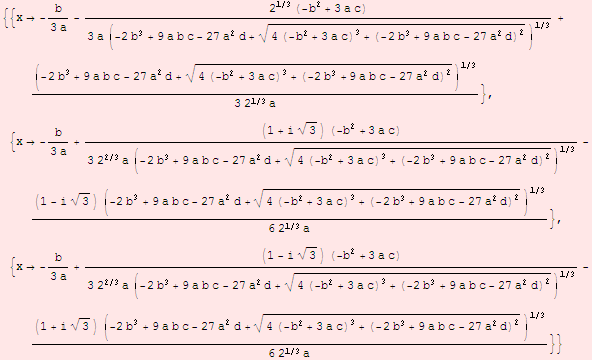แก้สมการแบบง่ายๆด้วย Solve[ ] และ Reduce[ ]
เราสามารถใช้ Mathematica แก้สมการง่ายๆด้วย Solve[ ] อย่าลืมว่าวิธีเขียนสมการนั้นให้ใช้เครื่องหมาย == (เครื่องหมาย"เท่ากับ"สองตัว ไม่ใช่ ตัวเดียว)
In[1]:=
![]()
Out[1]=
![]()
คำคอบข้างบนหมายถึง คำตอบของ![]() คือ
คือ ![]()
คำตอบของ Solve สามารถติดค่าตัวแปรอื่น
In[2]:=
![]()
Out[2]=
![]()
ทดลองให้ Solve[ ] หาคำตอบของสมการกำลังสามดู
In[3]:=
![]()
Out[3]=

บางครั้ง Solve[ ] จะเตือนเมื่อไม่มั่นใจว่าคำตอบที่ได้สมบูรณ์หรือไม่
ตัวอย่างข้างล่างเตือนว่า Solve[ ] พยายามหาคำตอบแต่อาจได้ไม่ครบ แนะนำให้ใช้ Reduce[ ] ด้วย
In[4]:=
![]()
![]()
Out[4]=
![]()
เมื่อใช้ Reduce[ ] ก็ได้คำตอบทั้งหมด คือ x เท่ากับ y (![]() + 2 n π) หรือ y (
+ 2 n π) หรือ y (![]() + 2 n π) เมื่อ y≠0 และ n เป็นจำนวนเต็ม
+ 2 n π) เมื่อ y≠0 และ n เป็นจำนวนเต็ม
(&& อ่านว่า "และ" ขณะที่ | | อ่านว่า "หรือ")
Reduce[ ] จะพยายามเขียนสมการหรืออสมการให้อยู่ในรูปที่ง่ายที่สุด (ที่ Mathematica คิด) ซึ่งทำให้เราได้คำตอบไปด้วย
In[5]:=
![]()
Out[5]=
![]()
Solve[ ] สามารถแก้สมการมากกว่าหนึ่งสมการได้ เพียงใส่สมการที่ต้องการเหล่านั้นเข้าไปในวงเล็บ{ }
ในตัวอย่างข้างล่าง Solve[ ] แสดงคำตอบที่ซ้ำกันออกมาด้วย ดังจะเห็นได้จาก ImplicitPlot[ ] ข้างล่าง
In[6]:=
![]()
Out[6]=
![]()
In[7]:=
![]()
![[Graphics:../HTMLFiles/chapter4_19.gif]](../HTMLFiles/chapter4_19.gif)
Out[8]=
![]()
เมื่อทดลองใช้ Reduce ดูจะได้คำตอบว่า y = -2(![]() ) และ x = ±
) และ x = ±![]()
In[9]:=
![]()
Out[9]=
![]()
ถ้าเราต้องการคำตอบเป็นตัวเลขเราก็สามารถใช้ N[ ] หรือ //N ได้
In[10]:=
![]()
Out[10]=
![]()
In[11]:=
![]()
Out[11]=
![]()
In[12]:=
![]()
Out[12]=
![]()
In[13]:=
![]()
Out[13]=
![]()
Reduce[ ] นั้นใช้กับอสมการได้ด้วย
In[14]:=
![]()
Out[14]=
![]()
เราสามารถจำกัดคำตอบของ Reduce[ ] ให้เป็นจำนวนเต็ม จำนวนจริง และจำนวนเชิงซ้อน
ตัวอย่างต่อไปไม่มีคำตอบถ้า x เป็นจำนวนจริง
In[15]:=
![]()
Out[15]=
![]()
แต่มีคำตอบถ้า x เป็นจำนวนเชิงซ้อน
In[16]:=
![]()
Out[16]=
![]()
ตัวอย่างต่อไปหาคำตอบที่เป็นจำนวนเต็มบวก
In[17]:=
![]()
Out[17]=
![]()
แต่บางครั้ง Reduce[ ] ก็จนปัญญาเหมือนกัน (Fermat's Last Theorem for n=3)
โดยตอบกลับมาแบบกำปั้นทุบดิน
In[18]:=
![]()
Out[18]=
![]()
Created by Mathematica (October 4, 2005)